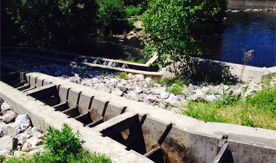
Sustainable Science in Action
Jeff Lord concedes he does a lot of sitting, watching and waiting along the herring ladder at Highland Lake. But when gangs of alewives begin to leap and flop their way upriver from Mill Brook, his patience is well rewarded.
“It can get a little boring, so I really appreciate when there is action,” the Falmouth resident said as he gazed at the rushing waters. “It’s a chance to put my biology background to work at something that matters.”
Lord and about 13 other volunteers keep count of migrating herring, mainly alewives, as they make their way up fish ladders to traditional freshwater spawning areas. The newly established volunteer monitoring program is a joint research project of UMaine and University of Southern Maine (USM). Scientists want to see if volunteers can help government managers and university researchers amass important data on spring run alewife — something likely too expensive to accomplish otherwise.
The now-retired Lord, who has a Ph.D. in entomology, saw a chance to use his biology knowledge in a public service capacity. He sees citizen programs as a way to engage the public by introducing projects that affect their home turf: “I think that as more people get involved in this type of project and communicate with others, there will be more support for these kinds of conservation efforts,” Lord said.
The role of citizen science in sustainable river herring harvest is the focus of a $96,600 grant from the National Fish and Wildlife Foundation. Growing out of a project at UMaine’s Sustainability Solutions Initiative, a program of the Senator George J. Mitchell Center, the overall goals are threefold:
- To study volunteer monitoring of river herring in Maine, Massachusetts, and New Hampshire, assess successes and difficulties and produce a road map useful to other groups interested in similar citizen science programs
- To help pilot communities develop these citizen fish-count programs while assessing the accuracy of the resulting data
- To explore the role of these programs, in local, state and regional fishery management
UMaine co-principal investigators are Karen Hutchins Bieluch, visiting assistant professor of communication and journalism, Linda Silka, director of the Margaret Chase Smith Policy Center and professor of economics; and Laura Lindenfeld, associate professor of communications and journalism and the Margaret Chase Smith Policy Center. Co-principal investigators from USM are Theodore Willis, adjunct assistant research professor of environmental science; and Karen Wilson, assistant research professor of environmental science. Jason Smith, master’s student at USM, is the project research assistant.
Volunteers for pilot projects in Windham and Pembroke, are already hard at work using good old-fashioned manual clickers to count as many fish as possible. Data from the Windham project is checked against recordings from a video camera installed by researchers. If the video and citizen counts match, the pilot program will be a viable alternative to expensive and difficult to maintain counting equipment, project scientists say.
This past year between 49,000 and 62,000 alewives climbed the Highland Lake ladder in Windham. The huge range occurred because a first wave of fish began leaving the lake before stragglers had finished migrating upstream, researchers say. It created some confusion for the volunteers, they said, something to iron out as the project moves forward. Though researchers hope to eventually have good estimates of newly spawned river herring streaming down the ladder, this first year focused mainly on citizen science group formation and learning methodology. Next year, researchers hope for a deeper pool of volunteers who will be ready to go by the start of migration in May. And if the adult count goes well next year, focus can shift to the little ones leaving the lake, which can number in the thousands per hour.
The big question: Can citizens be engaged in counts long term? USM fisheries scientist Willis thinks herring are charming enough to sustain interest.
“River herring are one of the few marine species that people can interact with because they swim inland to where we live,” Willis said. “There are dry spells in the counting, but then there will be 830 alewife an hour zipping past you. Early in the run there were thousands of fish piled up in the stream trying to work their way up the ladder.”
So much so that half the total count for 2014 was tallied in the first five days, Willis said.
Maine is one of only three states currently harvesting river herring and maintaining a viable fishery has been tough. Though herring fisheries are managed locally, they must comply with criteria issued by the Maine Department of Marine Resources (DMR). Among the rules:
- Herring harvest populations must be self-sustaining and not supplemented by outside stock. Noncompliance can result in a four-year shutdown.
- Total adult population must be estimated at 235 fish per surface acre.
- A run must demonstrate a healthy spawning survival rate and a good older age population.
“What we’re beginning to learn from our interviews is that these volunteer monitoring programs provide critical data for managers assessing the sustainability of a run for harvesting population trends, and the effectiveness of particular restoration efforts. More than just collection of data, these programs help build a sense of community around a local resource and increase local awareness of the fish. A sense of stewardship is essential for protecting river herring, now and in the future” said investigator Hutchins Bieluch.
Researchers are hopeful that this project will not only help jumpstart new monitoring programs, but will also facilitate communication between volunteers, local government officials, harvesters, and managers.
Contact: Tamara Field, 207.420.7755
